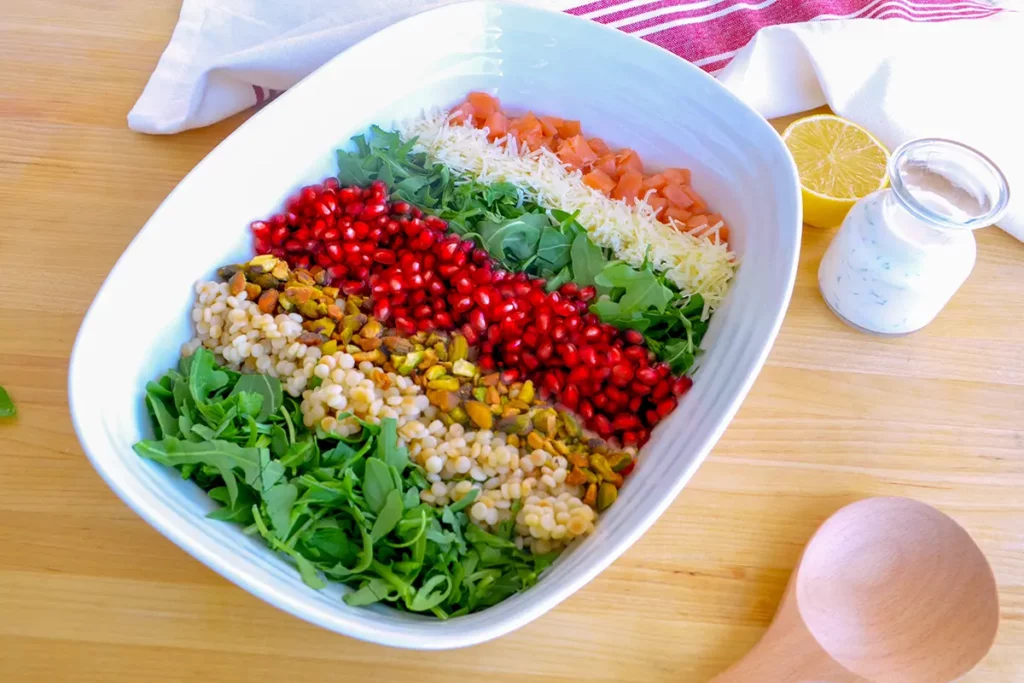Today’s Dietitian
Vol. 25 No. 9 P. 66
As a child, my mom would surprise my siblings and me every so often with unique grocery store finds. From shark to swordfish, it was amazing the foods she’d find in our small hometown of Fond du Lac, Wisconsin.
On one occasion, my mom brought home a fresh pomegranate, considered a rare jewel to me in the early 1990s. We stood in awe around the kitchen table while my mom added hundreds of ruby-red pomegranate arils—the juice and seed sacs inside the pomegranate—to a fruit salad. I still recall the juicy pop of sweet tartness upon my first bite.
Fortunately, today, whole fresh pomegranates and even cups of prepped pomegranate arils can be found in well-stocked grocery stores during pomegranate season. This fruit’s season typically runs from the end of October through the holidays—making it a perfect ingredient for holiday dishes. During these months, pomegranates are a staple on my grocery list.
Though native to the Middle East, 99% of commercially grown pomegranates in the United States hail from California, and people living in southern climates may be lucky enough to grow pomegranate trees in their yards.
A 1/2-cup serving of raw pomegranate arils contains 72 kcal, 16 g carbohydrate, 3 g fiber, 15% DV for vitamin C, and 4% DV for potassium.1
Perhaps the most unique nutrients in pomegranate arils are the polyphenol antioxidants.2 These antioxidants help fight free radicals, which are unstable molecules that, over time, can cause damage to our bodies.
Pomegranates are nutritional powerhouses, with each part of the fruit holding unique types of antioxidants. For instance, pomegranate arils contain anthocyanins, while the juice made from whole-pressed pomegranates also contains ellagitannins, which come from the hard rind and white pith.
I stir pomegranate arils into yogurt, sprinkle them on salads, or simply eat them with a spoon. It’s just that easy. So, this holiday season, encourage clients to honor their family traditions while creating new ones by enjoying the goodness of pomegranates.
— Michelle Dudash, RDN, is a Cordon Bleu–certified chef, author of Clean Eating Kitchen: The Low-Carb Mediterranean Cookbook (Fair Winds Press, 2021), and creator of Spicekick Seasoning Mix: Your Sidekick in the Kitchen.
Michelle Dudash, RDN, reports the following disclosure: She works as a dietitian spokesperson for POM Wonderful 100% Pomegranate Juice, Fresh Pomegranates, and POM Pomegranate Arils.
Chopped Salad With Israeli Couscous, Pomegranate, Smoked Salmon & Creamy Basil Dressing
Total prep and cook time: 1 hour
Yield: 8 side dish (1 cup) or 4 main dish (2 cups) servings
Ingredients
Couscous
1/2 cup dry Israeli (pearled) couscous
2 tsp extra-virgin olive oil, divided
Salad
4 cups arugula, chopped through a couple times
1 (4-oz) package smoked wild salmon, diced 1/4 inch
3/4 cup fresh pomegranate arils
1/4 cup shredded Asiago cheese (or Parmesan)
1/3 cup no-shell pistachios, chopped or crushed
Dressing
3 T milk
2 T mayonnaise
2 T nonfat plain Greek yogurt
2 T chopped basil (or 1 tsp dried)
1 T minced shallots
1 tsp lemon juice
Freshly ground black pepper
Directions
1. To make the couscous: Heat a small pot on medium heat. Add 1 tsp oil. Add the couscous and toast until golden, about 5 minutes, stirring occasionally. Cover with water (about 11/2 cups) and boil until al dente, about 8 minutes.
2. When the couscous becomes al dente, drain. Pour onto a plate, drizzle with 1 tsp oil, and spread couscous with a wooden spoon to cool quickly.
3. To make the dressing: Whisk together all of the dressing ingredients.
4. When ready to serve,* combine the cooked couscous, salad ingredients, and dressing in a large mixing bowl. Toss well. Salad may be served immediately and will stay fresh for a few hours.
Recipe Note
*For an impressive table presentation, spoon lines of the couscous and each salad ingredient in a wide, shallow serving or casserole dish. Cover and refrigerate until ready to combine with the dressing and serve.
Nutrient Analysis per serving (1 cup)
Calories: 175; Total fat: 9 g; Sat fat: 2 g; Cholesterol: 26 mg; Sodium: 152 mg; Total carbohydrate: 12 g; Total sugars: 3 g; Added sugars: 0 g; Dietary fiber: 2 g; Protein: 13 g
— Source: Recipe and photo courtesy of Michelle Dudash, RDN
References
1. FoodData Central. U.S. Department of Agriculture, Agricultural Research Service website. https://fdc.nal.usda.gov/fdc-app.html#/food-details/169134/nutrients. Published April 2018. Accessed August 24, 2023.
2. Kostka T, Ostberg-Potthoff J, Briviba K, et al. Pomegranate (Punica granatum L.) extract and its anthocyanin and copigment fractions—free radical scavenging activity and influence on cellular oxidative stress. Foods. 2020;9(11):1617.



